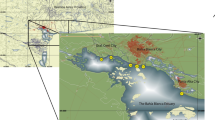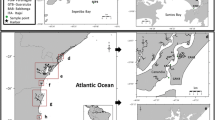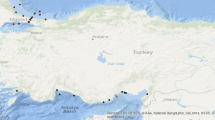Abstract
Butyltins were determined in seawater, sediments, and mussels (Mytilus edulis) collected from Busan Harbor, the largest commercial harbor in Korea, to assess the contamination status and the effectiveness of tributylin (TBT) restriction. TBT concentrations were found to be 7.6 ± 8.3 ng Sn/L in seawater, 387 ± 606 ng Sn/g dry weight (wt) in sediments, and 322 ± 167 ng Sn/g dry wt in mussels, and are comparable to those in the largest harbors worldwide. TBT levels were highest at locations near shipyards and related facilities. Busan Harbor was characterized by the long-term history of butyltin contamination, based on the lowered TBT/DBT ratios in environmental matrices. The temporal trend of TBT levels decreased significantly in seawater and mussels from 2002 to 2007, probably as a consequence of the legislative action in Korea (MOE Regulation 154/2000). However, TBT in sediments did not show any trend, suggesting a long half-life for TBT, about 17 years, in sediments.




Similar content being viewed by others

References
Arambarri I, Garcia R, Millán E (2003) Assessment of tin and butyltin species in estuarine superficial sediments from Gipuzkoa, Spain. Chemosphere 51:643–649
Berto D, Giani M, Boscolo R, Covelli S, Giovanardi O, Massironi M, Grassia L (2007) Organotins (TBT and DBT) in water, sediments, and gastropods of the southern Venice lagoon (Italy). Mar Pollut Bull 55:425–435
Bhosle NB, Garg A, Jadhav S, Harjee R, Sawant SS, Venkat K, Anil AC (2004) Butyltins in water, biofilm, animals and sediments of the west coast of India. Chemosphere 57:897–907
Burton ED, Phillips IR, Hawker DW (2004) Sorption and desorption behavior of tributyltin with natural sediments. Environ Sci Technol 38:6694–6700
Burton ED, Phillips IR, Hawker DW (2005) In situ partitioning of butyltin compounds in estuarine sediments. Chemosphere 59:585–592
Burton ED, Phillips IR, Hawker DW (2006) Tributyltin partitioning in sediments: effect of aging. Chemosphere 63:73–81
Busan Port Authority (2008) Shipping statistics in Busan Port. Busan Port Authority, Busan (in Korean), Korea
Canadian Council of Ministers of the Environment (CCME) (2004) Canadian environmental quality guidelines. Canadian Council of Ministers of the Environment, Winnipeg
Chagot D, Alzieu C, Sanjuan J, Grizel H (1990) Sublethal and histopathological effects of trace levels of tributyltin fluoride on adult oysters Crassostrea gigas. Aquat Living Resour 3:121–130
Choi M, Choi HG, Moon HB, Kim GY (2009a) Spatial and temporal distribution of tributyltin (TBT) in seawater, sediments and bivalves from coastal areas of Korea during 2001–2005. Environ Monitor Assess 151:301–310
Choi M, Moon HB, Yu J, Eom JY, Choi HG (2009b) Butyltin contamination in industrialized bays associated with intensive marine activities in Korea. Arch Environ Contam Toxicol 57:77–85
Coelho MR, Behianno MJ, Langston WJ (2002) Routes of TBT uptake in the clam Ruditapes decussates. I. Water and sediments as vectors of TBT uptake. Mar Environ Res 54:179–192
Devier MH, Augagneur S, Budzinski H, Le Menach K, Mora P, Narbonne JF, Garrigues P (2005) One-year monitoring survey of organic compounds (PAHs, PCBs, TBT), heavy metals and biomarkers in blue mussels from the Arcachon Bay, France. J Environ Monitor 7:224–240
Diez S, Ábalos M, Bayona JM (2002) Organotin contamination in sediments from the Western Mediterranean enclosures following 10 years of TBT regulation. Water Res 36:905–918
Diez S, Jover E, Albaiges J, Bayona JM (2006) Occurrence and degradation of butyltins and wastewater marker compounds in sediments from Barcelona harbor, Spain. Environ Int 32:858–865
Dowson PH, Bubb JM, Lester JN (1993) Temporal distribution of organotins in the aquatic environment: five years after the 1987 UK retail ban on TBT based antifouling paints. Mar Pollut Bull 26:487–494
Fent K, Müller MD (1991) Occurrence of organotins in municipal wastewater and sewage sludge and behavior in a treatment plant. Environ Sci Technol 25:489–493
Galante-Oliveira S, Oliveira I, Jonkers N, Langston WJ, Pacheco M, Barroso CM (2009) Imposex levels and tributyltin pollution in Ria de Aveiro (NW Portugal) between 1997 and 2007: evaluation of legislation effectiveness. J Environ Monit 11:1405–1411
Gibbs PE, Pascoe PL, Burt GG (1987) Sex change in the female dogwelk, Nucella lapillus, induce by tributyltin from antifouling paints. J Mar Biol Assoc UK 68:715–731
Gomez-Ariza JL, Morales E, Giraldez I (1998) Spatial distribution of butyltin and phenyltin compounds on the Huelva coast (Southwest Spain). Chemosphere 37:937–950
Hagger JA, Depledge MH, Galloway TS (2005) Toxicity of tributyltin in the marine mollusk Mytilus edulis. Mar Pollut Bull 51:811–816
Harino H, Fukushima M, Kawai S (1999) Temporal trends of organotin compounds in the aquatic environment of the Port of Osaka, Japan. Environ Pollut 105:1–7
Harino H, O’Hara SCM, Burt GR, Chesman BS, Langston WJ (2005) Distribution of organotin compounds in tissues of mussels Mytilus edulis and clams Mya arenaria. Chemosphere 58:877–881
Harino H, Yamamoto Y, Eguchi S, Kawai S, Kurokawa Y, Arai T, Ohji M, Okamura H, Miyazaki N (2007) Concentrations of antifouling biocides in sediment and mussel samples collected from Otsuchi Bay, Japan. Arch Environ Contam Toxicol 52:179–188
Harino H, Arai T, Ohji M, Ismail AB, Miyazaki N (2009) Contamination profiles of antifouling biocides in selected coastal regions of Malaysia. Arch Environ Contam Toxicol 56:468–478
Heroult J, Nia Y, Denaix L, Bueno M, Lespes G (2008) Kinetic degradation processes of butyl- and phenyltins in soils. Chemosphere 72:940–946
Hoch M (2001) Organotin compounds in the environment—an overview. Appl Geochem 16:719–743
Imaeda D, Kunisue T, Ochi Y, Iwata H, Tsydenova O, Takahashi S, Amano M, Petrov EA, Batoev VB, Tanabe S (2009) Accumulation features and temporal trends of PCDDs, PCDFs and PCBs in Baikal seals (Pusa sibirica). Environ Pollut 157:737–747
Kim NS, Shim WJ, Yim UH, Ha SY, Park PS (2008) Assessment of tributyltin contamination in a shipyard area using a mussel transplantation approach. Mar Pollut Bull 57:883–888
Langston WJ, Burt GR (1991) Bioavailability and effects of sediment-bound TBT in deposit-feeding clams, Scrobicularia plana. Mar Environ Res 32:61–77
Lee CC, Hsieh CY, Tien CJ (2006) Factors influencing organotin distribution in different marine environmental compartments, and their potential health risk. Chemosphere 65:547–559
Matthiessen P, Thain JE (1989) A method for studying the impact of polluted marine sediments on intertidal colonising organisms; tests with diesel-based drilling mud and tributyltin anti-fouling paint. Hydrobiology 188(189):477–485
Namiesnik J, Moncheva S, Park Y, Ham K, Heo B, Tashma Z, Katrich E, Gorinstein S (2008) Concentration of bioactive compounds in mussels Mytilus galloprovincialis as an indicator of pollution. Chemosphere 73:938–944
Nemanič MT, Milačič R, Ščančar J (2009) A survey of organotin compounds in the Northern Adriatic Sea. Water Air Soil Pollut 196:211–224
Ohji M, Arai T, Midorikawa S, Harino H, Masuda R, Miyazaki N (2007) Distribution and fate of organotin compounds in Japanese coastal waters. Water Air Soil Pollut 178:255–265
OSPAR (2004) OSPAR/ICES workshop on the evaluation and update of background reference concentrations (B/RCs) and ecotoxicological assessment criteria (EACs) and how these assessment tools should be used in assessing contaminants in water, sediment and biota (Final report), 9–13 February 2004, The Hague. OSPAR Commission and ICESCIEM
Page DS, Widdows J (1991) Temporal and spatial variation in levels of alkyltins in mussels tissues: a toxicological interpretation of field data. Mar Environ Res 32:113–129
Rato M, Ferreira N, Santos J, Barroso C (2009) Temporal evolution of imposex in Nassarius reticulates (L.) along the Portuguese coast: the efficacy of EC regulation 782/2003. J Environ Monit 11:100–107
Rees CM, Brandy BA, Fabris GJ (2001) Incidence of Imposex in Thais orbita from Port Phillip Bay (Victoria, Australia), following 10 years of regulation on use of TBT. Mar Pollut Bull 42:873–878
Ruiz JM, Bachelet G, Caumette P, Donard OFX (1996) Three decades of tributyltin in the coastal environment with emphasis on Arcachon Bay, France. Environ Pollut 93:195–203
Santos MM, Ten Hallers-Tjabbes CC, Santos AM, Vieira N (2002) Imposex in Nucella lapillus, a bioindicator for TBT contamination: re-survey along the Portuguese coast to monitor the effectiveness of EU regulation. J Sea Res 48:217–223
Sarradin P, Lapaquellerie Y, Astruc A, Latouche C, Astruc M (1995) Long term behavior and degradation kinetics of tributyltin in a marina sediment. Sci Total Environ 170:59–70
Shim WJ, Oh JR, Kahng SH, Shim JH, Lee SH (1999) Horizontal distribution of butyltins in surface sediments from an enclosed bay system, Korea. Environ Pollut 106:351–357
Sousa A, Matsudaira C, Takahashi S, Tanabe S, Barroso C (2007) Integrative assessment of organotin contamination in a southern European estuarine system (Ria de Aveiro, NW Portugal): tracking temporal trends in order to evaluate the effectiveness of the EU ban. Mar Pollut Bull 54:1645–1653
Sousa A, Laranjeiro F, Takahashi S, Tanabe S, Barros CM (2009) Imposex and organotin prevalence in a European post-legislative scenario: temporal trends from 2003 to 2008. Chemosphere 77:566–573
Strand J, Jacobsen JA, Pedersen B, Granmo A (2003) Butyltin compounds in sediment and molluscs from the shipping strait between Denmark and Sweden. Environ Pollut 124:7–15
Tolosa I, Readman JW, Blaevoet A, Ghilini S, Bartocci J, Horvat M (1996) Contamination of Mediterranean (Cote d’Azur) coastal waters by organotins and Irgarol 1051 used in antifouling paints. Mar Pollut Bull 32:335–341
United States Environmental Protection Agency (USEPA) (2003) Ambient aquatic life water quality criteria for tributyltin (TBT)—final. USEPA, Washington, DC
Acknowledgments
This work was funded by a grant from the National Fisheries Research and Development Institute (NFRDI; RP-2009-ME-49), Korea. We thank Drs. Rae-Hong Jung and Seong-Gil Kim for their valuable comments.
Author information
Authors and Affiliations
Corresponding author
Rights and permissions
About this article
Cite this article
Choi, M., Moon, HB., Yu, J. et al. Temporal Trend of Butyltins in Seawater, Sediments, and Mussels from Busan Harbor of Korea Between 2002 and 2007: Tracking the Effectiveness of Tributylin Regulation. Arch Environ Contam Toxicol 58, 394–402 (2010). https://doi.org/10.1007/s00244-009-9428-2
Received:
Accepted:
Published:
Issue Date:
DOI: https://doi.org/10.1007/s00244-009-9428-2



